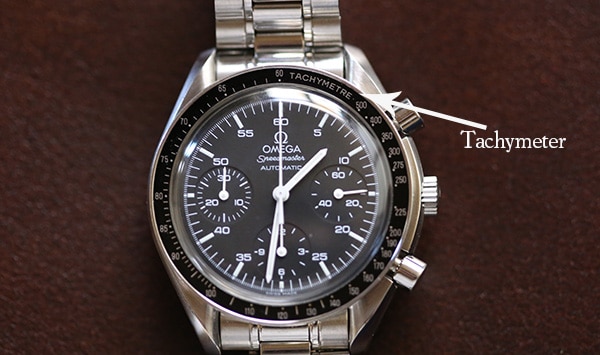Notice that the second hand in the right sub-dial keeps moving even when the chronograph’s second hand is stopped and that the chronograph’s second hand only starts when you push the start button on the chronograph.
The chronograph’s minute hand on this watch is on the left-side sub-dial. It lets you know many minutes have passed since you started the stopwatch. As you can see, it tracks up to 30 minutes.
The chronograph’s hour hand on this watch is the bottom, middle sub-dial. It tells you how many hours have passed since you started your stopwatch.
How to Use a Tachymeter

Alright, so using a chronograph is easy. It’s just a stopwatch.
Let’s move on to tachymeters. Using them requires a bit of mental math, but once you understand how to use it, you’ll be able to measure all sorts of things like speed and distance traveled, as well as fuel consumption (if you have a special ruler slide tachymeter bezel).
A tachymeter is a scale that’s inscribed around the bezel of a watch or the outside edge of the watch’s main dial. The formula to create this scale is:
Tachymeter scale value = 3,600 (number of seconds in an hour)/elapsed time in seconds
The scale allows you to convert elapsed time (in seconds per unit) to speed (in units per hour).
Most tachymeter scales only work and are valid for all elapsed times starting at about 7.2 seconds and up to 60 seconds. Notice on this Speedmaster that the scale begins at 500 at around the 7.2-second hash. So if you’re trying to measure the speed of something that has an elapsed time of less than 7.2 seconds, the tachymeter isn’t going to work for you. For things that take longer than 60 seconds to complete, you can still use a tachymeter to figure out the speed, you’ll just need to do some math. More on that in a bit.
Also keep in mind that a tachymeter can only measure known distances up to 1 full mile or 1 full kilometer. It’s possible to measure speed for objects that travel shorter or longer distances, you just need to do some math.
Let’s take a look at how to use a tachymeter to measure speed and distance in a few different scenarios.
...[ Continue to next page ]
Share This Post














